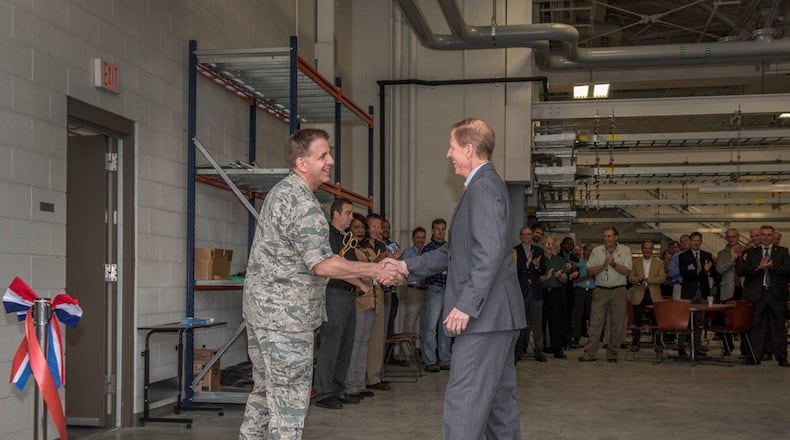The building was once home to a 5-foot wind tunnel and supporting facilities that was completed in 1922 at McCook Field and commissioned by an inspection team that included Orville Wright. The wind tunnel was a critical component in aircraft technology development for many years. In 1929, it was moved to its new home in Bldg. 19, which was specially built for the tunnel, the longest continually operating wind tunnel in the world. It ran for 88 years until the decision was made to reconfigure the facility.
Although the wind tunnel served an important role in the development of powered flight, new challenges in aircraft power and thermal advancement face researchers today and into the future with fifth and sixth generation airpower capabilities.
“Today, we unveil our newest research capability after many years of planning, construction and perseverance,” said Christopher Greek, chief, Power and Control Division. “The building you’re standing in is one of the most historic buildings on one of the most historic bases in the country. There’s a great legacy and heritage here with the building, and 90 years later we’re on these hallowed grounds to continue this groundbreaking research.”
The newly remodeled facility offers 17,000 square feet of flexible and reconfigurable research space for applied research in aircraft systems integration. The facility includes support for future experiments in power distribution and thermal management on aircraft, using the available cooling and power connections so that an experiment can be set up or reconfigured with minimal turn-around time.
The new facility design includes two bays each served by two drive stands, cooling, power, research air, and instrumentation, and a modeling and simulation laboratory. The design provides the capacity to handle a large number of both integrated and stand-alone experiments at the same time.
“Although we acknowledge the history of what was accomplished in this building, the Air Force has always been a service that looks toward the future, and right now, the Air Force is facing a daunting challenge,” said Col. Joel Luker, deputy director, Aerospace Systems directorate.
“Throughout the Air Force’s history, as we built fighter aircraft and those sorts of systems, the power and thermal issues were never really a concern – there was so much margin available in the design. But what we’ve learned over the past couple years when you look at the advent of electronic warfare, radar systems we’ve got in our fighters today, and the things that we’re asking them to do, particularly the F-22 and F-35 and even some of our older systems, like the F-15 and F-16, we’re putting radars and other capabilities into those jets, the power/thermal margins are just not there anymore.
“So here we are 100 years into the research and development that’s gone on here at Wright-Patt and aircraft development and we’re really looking at a new field that hasn’t been looked at in that way before. We’re realizing we have to do a lot more research in power and thermal systems and integrating those together, controlling them as one unit to optimize the aircraft design,” Luker said.
With completion of the renovation of the facility according to historical and architectural requirements, Bldg. 19 is now ready to support the work of researchers for years to come.
Greek said that Bldg. 19 is now beginning to come online and will be used for integrated electrically generated power and thermal systems for in-house research and to develop competencies of the workforce through these kinds of projects but also to bring in industry in a non-proprietary fashion to do experiments as well.
The facility is also supporting some programs from other divisions within AFRL such as the Low-Cost Attritable Strike Demonstrator, or LCASD, a high-speed, long-range, low-cost, limited life-strike unmanned aircraft system.
“We can do a lot of things on the ground in a controlled laboratory environment before you go off and put it on an airplane and do a flight test or do something that is a lot more expensive and maybe riskier,” said Dr. Russell Spyker, deputy for Research Facilities in the Power and Control division.
The Power and Control division receives frequent requests from other organizations to replicate conditions in the lab that have been experienced in the field.
“These are usually odd things where people may have a problem on an airplane and they want realistic aircraft power, so we have a large collection of aircraft generators in our inventory all the way from B-52s, C-130s, A-10s, F-15s, F-16s and others. Someone could come in here and say, ‘I need to put 400HZ, 115V, 3-phase power on a piece of equipment,’ and we can do that here in this lab,” Spyker said.
Bldg. 19 once again supports the Air Force’s ability to control the skies with a vision toward the future, just as it did when the Wright brothers worked to achieve the first powered, sustained and controlled airplane flight all those years ago.
About the Author
